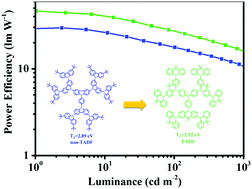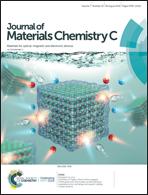Solution processible triphenylphosphine-oxide-cored dendritic hosts featuring thermally activated delayed fluorescence for power-efficient blue electrophosphorescent devices†
Abstract
Based on oligocarbazole, a carbazole/acridine hybrid and oligoacridine as the dendron, a series of solution processible triphenylphosphine-oxide-cored dendrimers denoted as 3CzCz-PO, 3AcCz-PO, and 3AcAc-PO have been designed and synthesized, respectively. With increasing electron-donating ability from the peripheral dendron, the singlet–triplet splitting (ΔEST) is found to be gradually reduced from 0.35 eV for 3CzCz-PO to 0.22 eV for 3AcCz-PO and 0.20 eV for 3AcAc-PO while retaining high triplet energy (T1) around 2.9 eV. As a result, 3AcAc-PO exhibits an obvious thermally activated delayed fluorescence (TADF) with a lifetime of 1.0 μs. When used as the host for the blue phosphor Ir(mpim)3, the corresponding solution-processed devices reveal a peak power efficiency of 46.4 lm W−1. And about 57% improvement is obtained for 3AcAc-PO compared with the non-TADF host H2 (29.6 lm W−1). The results clearly manifest the superiority of solution processible dendritic TADF hosts in power-efficient blue electrophosphorescent devices.



 Please wait while we load your content...
Please wait while we load your content...